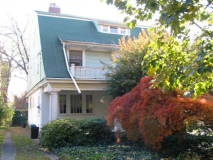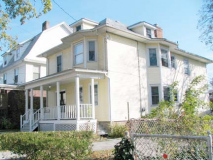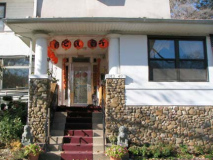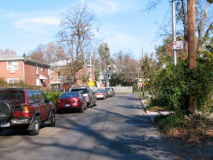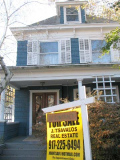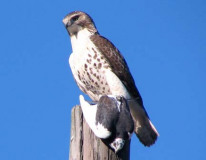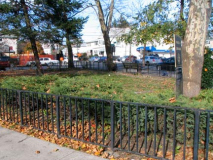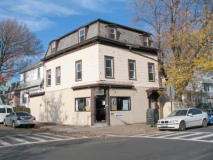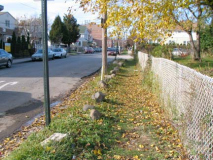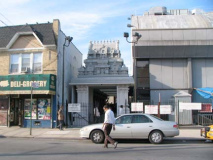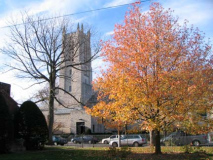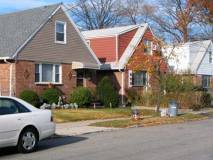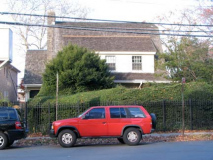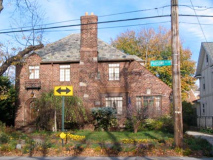In a borough that ruthlessly changed most of its street names to numbers beginning in the 1910s (beginning in Woodhaven, actually) there are, interestingly, still pockets of streets named in alphabetical order scattered throughout. There’s Elmhurst (Aske through Macnish); East Elmhurst (Butler through Humphreys); Rego Park (Asquith Crescent through Fitchett Street); Forest Hills (Austin through Olcott); Auburndale (Ashby through Gladwin); Bellerose (Davenport through Fairbury); Hollis (Arcade through Tioga) … have I missed any? The most historic such sequence, though, is in Flushing: its series of alphabetical street names is an indicator of a past quite different from its present.
Flushing’s alphabetical set of streets runs, very roughly, from Kissena Boulevard (formerly the Jamaica Road, the main route between Flushing and Jamaica) east to Parsons Boulevard or 156th Street on the east, and Kissena Park on the south. Most of the streets have plant names and run from Ash Avenue to Rose Avenue. This is a legacy of the Robert Prince commercial plant nursery, established around 1735, taht gradually expanded to 115 acres and was joined by competing commercial plant farms. They thrived until after the Civil War, after which Flushing became increasingly urban and the land ws needed for housing.
GOOGLE MAP: Flushing’s Plant Avenues
Ash Avenue
Named, of course, for the North American and European ash tree, heavily used in wood products calling for strength and resilience. Flushing’s Ash Avenue is the most disjointed avenue in the sequence, running from Kissena Boulevard east to Parsons Boulevard, again from 147th Street east to 149th Street, and then from 149th Place east to just beyond Murray Street.
Between Kissena and Parsons Boulevards, Ash Avenue runs through the gorgeous, yet non-landmarked and therefore endangered Waldheim neighborhood, and is home to some of Flushing’s most varied architecture. Waldheim was developed in the early 20th Century by developers George Appleton and W.B. Richardson.
From FNY’s Waldheim page: The developers set to work building luxury housing and cutting through streets, named for plants in a likely hommage to Flushingís former plant nurseries. Many of the old woodsí huge trees were retained as street trees, and the developers named the tract Waldheim, German for “woods home.” A small number of architects under the supervision of Appleton worked on the new neighborhood, which originally attracted Flushing’s wealthier set: at one time, the founder of Buster Brown shoes, the Hellman family of mayonnaise fame, and members of the piano-manufacturing Steinway family lived in Waldheim, as well as Appleton and Richardson themselves.
Ash Avenue’s east side, at 149th Street, offers the picturesque Unitarian Universalist church, founded in Queens in 1905. The present church building opened in 1916. One of the founding congregants was Lewis Howard Latimer (1848-1928), a protege of Alexander Graham Bell and the inventor of the electric light bulb filament. Latimer’s former house, once at Holly Avenue and Kissena Boulevard, was moved to 137th Street north of Northern Boulevard in the 1990s.
Ash Avenue between 147th and 149th (1 block) features a number of picturesque homes, including the Pearl (Kabriski) Mansion at 147-38. The house was originally the Charles Pearl mansion: Pearl built the Italianate house on a 5-acre tract facing today’s Sanford Avenue and 149th Street. The interior boasts oak and pine floors, marble sinks, and floor to ceiling windows. It has been owned by the Kabriski family for a number of years. Its next-door neighbor is almost as distinctive. Here’s the Pearl Mansion about 1900.
Beech Avenue
It’s appropriate that the B avenue in the sequence is Beech — the famed Weeping Beech at the Kingsland Homestead, 37th Avenue west of Parsons Boulevard, was imported by the Prince family and was a living NYC Landmark until its death in 1998. Beech Avenue runs continuously from Kissena Boulevard east to 156th Street. (A second “B” avenue, Blossom, runs between College Point Boulevard and Main Street.)
Beech Avenue and Phlox Place, Waldheim; Buddhist temple, 146-19 Beech Avenue east of Parsons Boulevard
In the late 1990s your webmaster looked at an apartment in this 5 story Tudor building on Beech east of 147th Street, finding the price too rich (I’m glad I wound up in Little Neck anyway). Across the street is a porched building typical of the early 20th Century architecture in Waldheim and Ingleside, its neighbor to the east.
Tragically, Waldheim has never been designated for landmark status by the Landmarks Preservation Commission, and now joins Astoria Village in being plundered by modern-day developers, who have none of the esthetic sense of their forebears and have been merrily tearing down Waldheim’s homes in favor of multi-family people storage.
We’re now on 147th a little south of Beech but I had to include the silver domed Russian Orthodox Church of the Holy Annunciation.
Two Tudors; unusually large plot for this neighborhood, Beech east of Parsons; Beech Avenue and Murray Street.
Cherry Avenue
Cherry Avenue runs in two sections: Crommelin Street (the ancient right of way of the A.T. Stewart Central Railroad of Long Island) east to Colden Street, and from Kissena Boulevard east to 156th Street and 43rd Avenue. At present, it is the one of three names in the sequence named for a fruit tree. Early in its existence it was known as Cypress Avenue, but it seems to have been renamed Cherry by the late 1920s.
Two gateposts on the west side of Bowne Street at Cherry Avenue. Though they are not in Waldheim proper, which bgins on the other side of Bowne street, they serve to announce the now-shrinking neighborhood. They were beginning to crumble a few years ago but were restored in 2005. I wish Waldheim’s buildings could be as diligently protected, but that seems to be a very tough assignment.
A pair on Cherry Avenue and Burling Street, with assembled stones a major component. Bayside’s stone house on Bell Boulevard is somewhat more celebrated.
East Flushing’s most extravagant building, a turreted marvel at Cherry Avenue and Murray Street. I imagine there’s brickfacing underneath the siding.
The stone wall, iron gate, and bluestone sidewalk are likely the originals.
Elsewhere on Cherry Avenue, we find bluestone from the curb to the sidewalk, and in some cases, a step to allow egress from a wagon to the sidewalk without the threat of muddy boots.
147th and Cherry. Frame house typical of the area, and a view of the Russian Orthodox church seen previously.
Cherry Avenue looking toward Parsons. In these parts, a “for sale” sign usually means a demolition is in the offing, as modern day developers prefer multifamily units.
Magnolia, Syringa and Phlox
In the heart of Waldheim we find three small Places, also given plant names: Syringa and Magnolia Places, which connect Ash and Beech Avenue at sweeping angles, and Phlox Place, between Beech and Cherry Avenues. All three are named for flowering plants, with lilac the commoner term for syringa.
The main feature on Phlox Place is Waldheim’s only large apartment building. This was formerly marked “One Phlox Place” above the door, but that had disappeared when I last visited; it must have confused the Post Office. the actual address is 42-66 Phlox Place.
Delaware Avenue
Delaware is the exception to the rule, as it is one of three place names and one of two US state names in the sequence. The avenue has never carried a name other than Delaware, although the D’s begin a trend in the Flushing plant name sequence: in some cases, the avenue west of Kissena Boulevard has a different one from the avenue east of Kissena. Dahlia Avenue, not pictured here, runs a block on the north side of the Queens Botanical Garden between Crommelin and Main Streets.
Beauty and the beast. Double house, likely built between 1920 and 1930, left, and balustraded monstrosity, 2000s, right. Any homeowners or architects out there who owns or has built one of these things? Tell me why you like it. I’m curious to know. Both between Murray and 149th on Delaware Avenue.
Charming cottage-like homes, 147th Street and Delaware Avenue. A Delaware Avenue red-tailed hawk and its lunch.
Elm Avenue
Elms originated in central Asia 40 million years ago and spread throughout the northern hemisphere. Dutch Elm disease cut the species’ numbers drastically in the 1960s. One of the oldest Elms in the world was planted in 1350 in Biscarrose, France, but it now seems on its last mile.
Elm Avenue in Flushing runs between Burling Street east to 156th. Its western extension between Main Street and Kissena Boulevard is called Elder Avenue.
Use ’em or lose ’em. The mansion on the corner of Elm Avenue and 149th Street was uncared-for with overgrown weeds in the front yard. It was finally sold and demolished, and doctrinaire multifamily homes now occupy its old space.
There are Elm Avenue beauties still around, though; a Tudor mansion (apparently now a collection of doctors’ offices) at 147th Street and Parsons Boulevard, and this Ionic-columned beauty between 149th and Murray.
Flushing Hospital, facing 45th Avenue and Parsons Boulevard, looms over Elm Avenue in photo left. The hospital was established in 1883.
General George Lawrence Triangle, at Elm and 45th Avenues and Parsons Boulevard, was named for a local doctor and militiaman who fought in both World Wars. Lawrence (1881-1949) graduated from the University of Pennsylvania with an MD in 1907 and practiced at Flushing Hospital, heading departments of obstetrics and gynecology. After World War II, during which he became a brigadier general, he served as vice-president of Flushing Savings Bank. The park was named for him in 1951. It is marked by one of the only remaining white Queens street signs from the mid-20th Century.
Franconia Avenue
One of three avenues in the sequence named for locations, not plants, Franconia Avenue, a region in southern Germany (In German, Franken) including northern Bavaria. The largest city in Franconia is Nuremberg, and picturesque Rothenberg preserves many beautiful buildings from the medieval era and is a worldwide tourist attraction.
Franconia Avenue was renamed 45th Avenue in the mid-20th Century for reasons that escape me. A trolley line from Jamaica once ran along 45th Avenue (and 164th Street, a clue for the reason for that street’s great width). 45th Avenue is the only numbered avenue in western Flushing between Ash and Rose Avenues. The only modern-day clue about its former name is the drugstore at 45th Avenue and 162nd Street on the Auburndale border.
Georgia Road
Shown on older maps from the 1920s as Grape Avenue, Georgia Road, the only one in the sequence called “road” instead of “avenue” runs from a block from Burling Street to Parsons Boulevard. There is a flower “G” avenue, Geranium Avenue, between Colden Street and Kissena Boulevard.
A handsome castle-like apartment building can be seen on Parsons Boulevard between Georgia Road and Hawthorn Avenue.
Hawthorn Avenue/Hollywood Avenue
Hawthorns are flowering shrubs and trees native to the northern hemisphere that number over a thousand species. The ‘haw’ refers to its berry-like fruit. “H” is represented by three avenues in the sequence, with Hawthorn Avenue running between Burling Street and 156th Street, Hollywood Avenue between 149th and 156th (one block), and in western Flushing, and Holly Avenue (below) between Kissena and Parsons Boulevards.
Holly Avenue
Odd that there is no “I” avenue, since Holly Avenue could have been called by its Linnean name, Ilex. Holly berries, quite popular for decoration during the holiday season, are actually rather toxic, for humans at least; birds love them.
Venerable building with mansard roof and dormers, Holly Avenue and Burling Street; no sidewalks necessary, apparently, a reminder of a suburban legacy at Holly Avenue and Smart Street
Beauty and the Beast Part 2: the Ganesha Temple of the Hindu Temple Society of North America on Bowne Street just north of Holly was opened on July 4, 1977. Unfortunately, the Society constructed a beetling, bruising community center (left) on Smart and Holly in the late 1990s that in no way resembles the Ganesha Temple, though the Holly Avenue entrance does.
In 2009, the Temple was undergoing an expansion, and I’d hope they do something with those blank walls. The Temple’s former appearance is sbown on the website linked below.
As the first Hindu Temple in North America composed of largely imported materials, and constructed by artisans from India, Sri Maha Vallabha Ganapati Devasthãnam (or the Ganesha Temple) is one of the most impressive and historically important Hindu temples in the West. Flushing, Queens was chosen as the location for the Ganesha temple based on three criteria: it was the gateway of the U.S.- all Indian immigrants came here and there was a large concentration of Hindus in the tri-state area of New York, New Jersey, and Connecticut; it was within walking distance for many, or one bus or subway fare; and the possibility existed to purchase a suitable site. Its strength and influence outside of New York is proven by the fact that the temple has served as a model for many other Hindu communities. Hindu Temple Society of North America
Jasmine Avenue
One of the few avenues in the sequence named for an old world plant, the Jasmine’s name is derived from Persian for “gift from God.” It is the national flower of the Phillipines, Indonesia and Pakistan. In China the flowers are used to produce tea. In Flushing Jasmine Avenue runs between Burling Street and 156th. A second “J” avenue, Juniper, runs between Colden Street and Kissena Boulevard.
The St. Mary’s Nativity Roman Catholic Church’s campanile towers over Jasmine Avenue between Burling Street and Parsons Boulevard. The parish was established in 1926 and the school; cenacle and rectory buildings all appear about right for that year, but the light brick church seems newer, about 1950-1960, I’d guess. The cornerstone is obscured by shrubbery.
Some of the original brickfront pokes through the siding on this Jasmine Avenue attached house. I couldn’t resist shooting the church again from Parsons Boulevard this time with some fall color.
Kalmia Avenue
Kalmia are evergreen shrubs and trees native to mostly North America, bearing small white, pink or purple blooms that grown in 6″ clusters. The plant was named for Finnish botanist Pehr Kalm. Flushing’s Kalmia Avenue runs in two sections: between Colden Avenue and Kissena Boulevard and from Burling Street east to 156th.
At Kalmia and Kissena (is there another K-K intersection in Queens?) a new pagoda-esque structure with hand painted decoration has recently been constructed. Anyone know its purpose?
Laburnum Avenue
Laburnum, amusingly called the Golden Shower Tree or Golden Chain Tree, are native to southern Europe and feature yellow flowers in lengthy clusters. Continuing something of a tradition among Flushing plant avenues, Laburnum joins Holly and Kalmia in being toxic if consumed; Laburnum is the most posionous of the bunch — and Laburnum are in the pea family and its seed pods resemble peas. Caterpillars like the plant just fine. I can’t help but think “and Shirley” when hearing the plant name.
In Flushing Laburnum Avenue is one of the lengthiest ‘plant’ avenues, extending from Colden Street all the way east to 164th Street.
A lonely conifer greets the perambulator at LaburnumAvenue and Bowne Street. RIGHT: East Manor Restaurant at Kissena Blvd. and Laburnum Avenue.
Mulberry Avenue
The Mulberry is a common species native to temperate and subtropical regions of Asia, Africa, Europe, and the Americas, with the majority of the species native to Asia. The fruit is edible on its own and is used to produce pies and liqueurs. It can also be used as a food colorant. Mulberries are also important to the silk industry as its leaves are a major food source for silkworm moth larvae.
Mulberry Avenue runs for just over one block, from Colden Street to just past Kissena Boulevard.
Mulberry Avenue features some neat A-frame homes with postage stamp lawns. A mid-century view of suburbia. Mulberry, along with Ash (just east of Murray Street) is the only dead-end avenue in the series.
Negundo Avenue
I confess, Negundo is the only plant in the series of which I hadn’t heard — at least its name. Negundo is a species of maple tree also known as the box elder and maple ash (making Elder Avenue and Ash Avenue somewhat redundant). The trees can be found all over North and Central America. Its wood is light and is used for fiberboard.
Very old dwelling, Kissena Boulevard and Negundo Avenue. Kissena Boulevard is a very old road, originally one of the only direcdt roads from the town of Flushing to Jamaica. Jamaica road’s original route can be traced along Kisena Boulevard, Aguilar Avenue, and Parsons Boulevard to Jamaica’s heart. Above right: another series of tidy A-frames. Gambrel roof, Negundo and Bowne.
Oak Avenue
Though squirrels love acorns, they are poisonous to horses in great quantities. Possibly the most revered tree in the world, the Oak is the national tree of England, Estonia, France, Germany, Moldova, Latvia, Lithuania, Poland, the United States, Basque Country, Wales, Bulgaria and Serbia.
Along with Rose Avenue, Oak Avenue is the most scenic plant avenue in Flushing, as it runs along the northern edge of Kissena Park for a few blocks.
Parsons Boulevard and Oak Avenue
Above left: Kissena Park entrance, Oak Avenue and 160th Street. Right: when I lived a few blocks away, I always made sure to go past this house after a snow storm — the eaves would be ful of giant icicles.
The dreaded for sale sign has appeared outside this rambling house, and the house will likely be rambling to oblivion soon.
Poplar Avenue
Poplars are among the fastest growing trees in North America and are important wood trees, and are also used in the production of adhesives and bioenergy.
Parsons Boulevard ends at Rose Avenue; ahead is the Kissena Park Korean War Memorial.
Rose and Oak Avenues. Poplar Avenue runs for three blocks between Kissena Boulevard and Parsons Boulevard.
A tale of two decades at Parsons Boulevard and Poplar Avenue. On the left a stately Tudor with casement windows, 1940 or so; on the right, across the street, a balustraded, metal balconied fresh piece of Queens Crap. Enjoy your new house. Only small minds design objects like this.
Quince Avenue
Quinces are related to apples and pears. The fruits were used as ritual offerings at weddings in ancient Greece; Quince was originally native to the Caucasus and today Turkey remains the world’s largest Quince producing country. Only one variety can be eaten raw; quinces are usually cooked or stewed before they are consumed because they tend to be too sour when raw. (I confess I have never tried one).
Quince Avenue runs from Kissena Boulevard northeast to Oak Avenue at 158th Street.
Cabbies should not confuse Quince Avenue with the soundalike Quencer Road, miles to the south in St. Albans.
Rose Avenue
Roses originated in what is today Persia, over 35 million years ago. Rose Avenue originates at Kissena Boulevard and the western edge of Kissena Park, and borders the park until its end at Oak Avenue.
Would you plant a rose garden if you lived on Rose Avenue? Of course you would.
Two houses built along Rose Avenue take advantage of the park setting across the street.
Suppose there were S, T, U, V, W, X, Y, Z avenues in the series? What names could they have?









